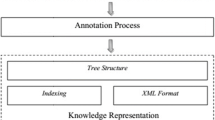Abstract
When using the current method to update the index of educational resources, there is no analysis of the hierarchical association structure between educational resources. There are some problems such as too long index construction time, high query time and low query accuracy. Therefore, this paper introduces mobile computing to study the adaptive updating method of education resource index. This paper analyzes the structure of the index system of educational resources. On the basis of mobile computing, the hierarchical association structure between educational resources is analyzed by LDA (Latent Dirichlet Allocation) topic modeling and topic hierarchical clustering. The initial query is expanded by selecting extension words by local co-occurrence method. The weight of the extended query is allocated by genetic algorithm to realize the adaptive updating of the index of educational resources. The experimental results show that when the number of nodes is 25 × 104, the total query time of this method is only 3.5 s, and the average index redundancy rate is only 0.22%, indicating that the resource index update performance of this method is better.







Similar content being viewed by others
Change history
05 November 2021
A Correction to this paper has been published: https://doi.org/10.1007/s11036-021-01853-y
References
Wei C (2020) 5G-oriented IOT coverage enhancement and physical education resource management[J]. Microprocess Microsyst 12(10):33–36
Rasmussen SHR, Nørgaard AS (2018) When and why does education matter? Motivation and resource effects in political efficacy[J]. Eur J Polit Res 57(01):153–167
Wang B, Hao MQ, Li PC, Xiao H (2019) Quantum indexed image description method and steganography algorithm. J Comput Aided Design Graphics 31:1995–2006
Junliang Z, Xingyue Z, Dongdong Y (2019) Study on the alleviating effect of public education resources and family education investment on education poverty[J]. Population Journal 41(02):20–32
Li JJ, Zang YX, Liu XY, Xia XF, Zhu R (2019) Spatial index method for time-dependent road network. Comput Eng 45:133–140
Peng ZJ, Feng JX, Wang QS, Xiong W (2017) A moving object indexing method that supports frequent location updates. J Geo-Inform Sci 19:152–160
Li JJ, Zang YX, Liu XY, Xia XF, Zhu R (2019) Spatial index method for time-dependent road network. Comput Eng 045:127–134
Ren CL, Jiang LY, Shan XH, Song BY (2019) Large-scale dynamic label map subgraph query based on hierarchical sequence index. Comput Eng Appl 055:70–75
Zhang YQ, Shi GY (2018) An efficient indexing method for ship dynamic data. China Navigation 041:5–11
Shuai L, Chunli G, Fadi A et al (2020) Reliability of response region: a novel mechanism in visual tracking by edge computing for IIoT environments. Mech Syst Signal Process 138:106537
Liu S, Liu X, Wang S, Muhammad K (2020) Fuzzy-aided solution for out-of-view challenge in visual tracking under IoT assisted complex environment. Neural Comput Applic 33:1055–1065. https://doi.org/10.1007/s00521-020-05021-3
Liu S, Wang S, Liu X, Lin CT, Lv Z (2020) Fuzzy detection aided real-time and robust visual tracking under complex environments. IEEE Trans Fuzzy Syst:1. https://doi.org/10.1109/TFUZZ.2020.3006520
Yao LH, Yu GZ (2019) Relational database information resource retrieval results classification method simulation. Computer simulation 36:445–448
Mugendawala H, Muijs D (2020) Educational process factors for effective education in resource-constrained countries: a multilevel analysis[J]. Sch Eff Sch Improv 31(3):1–23
Li LX (2020) Design of college education information recommendation system based on multivariate hybrid criteria fuzzy algorithm. Modern Electronic Technology 043:97–99,103
Czaja P (2018) World trends in human resource education for mineral engineering and mining[J]. Inzynieria Mineralna 19(1):179–188
Rong HP (2018) Implementation model and safeguards for cross-media semantically related retrieval of library digital resources. Library Work and Research 000:58–62
Zahay D, Altounian D, Pollitte W et al (2018) Effective resource deployment in digital marketing education[j]. Mark Educ Rev 2:1–11
Be AVK, Qudsi RA, Usoro AO et al (2019) Education improves musculoskeletal radiology interpretation by trainees in a low-resource setting[J]. Journal of Surgical Education 76(6):1605–1611
Kemal I, Suryadi S, Rosyidi U (2019) Management of Lecturers Resource Development at higher education[J]. International Journal of Higher Education 8(5):246–253
Shuai L (2019) Introduction of key problems in long-distance learning and training. Mobile Networks and Applications 24(1):1–4
Troupe G, Peterson MK, Golick D (2018) Improving genetic engineering secondary education through a classroom-ready online resource[J]. Journal of Agricultural & Food Information 19(1):37–54
Elmas R, Türkolu ME, Aydodu B (2019) Education themed movies as a teaching resource for pre-service science teacher education[J]. Kuramsal timbilim 12(4):1324–1339
Santoso HB, Desprianto DA, Nurrohmah I (2019) Customer journey construction of the Indonesian open-education resources platform[J]. International Journal of Emerging Technologies in Learning (iJET) 14(24):18–24
Tang YF, Chen SP (2018) Using k-d tree index to improve data stream skyline query algorithm. Small microcomputer system 39:146–152
Acknowledgements
The research is funded by Teaching reform and Innovation Project of Shanxi Province colleges and universities (The optimization and practice of the talent training system of physics in local colleges based on the accreditation of normal education).
Author information
Authors and Affiliations
Corresponding author
Additional information
Publisher’s note
Springer Nature remains neutral with regard to jurisdictional claims in published maps and institutional affiliations.
The original online version of this article was revised: The original version of this article, published on 5 May 2021, the authors have found an error in the published version of the paper. Typesetter inadvertently added the section heading "2 Conclusion" between "1 Introduction" and "3 Characteristic analysis of educational resource index" sections in the attached published version. This should be deleted.
Rights and permissions
About this article
Cite this article
Liu, JW., Sangaiah, A.K. Research on Adaptive Updating Method of Education Resource Index Based on Mobile Computing. Mobile Netw Appl 26, 2153–2162 (2021). https://doi.org/10.1007/s11036-021-01771-z
Accepted:
Published:
Issue Date:
DOI: https://doi.org/10.1007/s11036-021-01771-z




